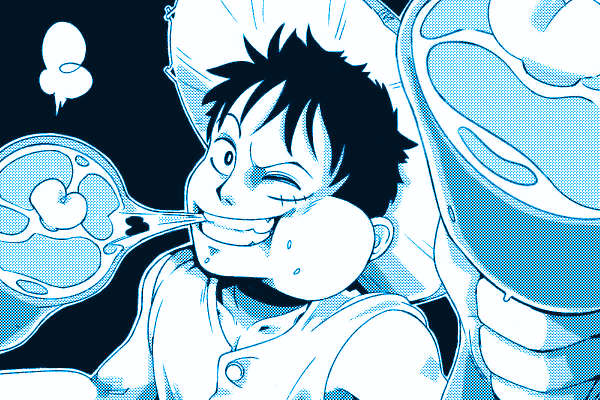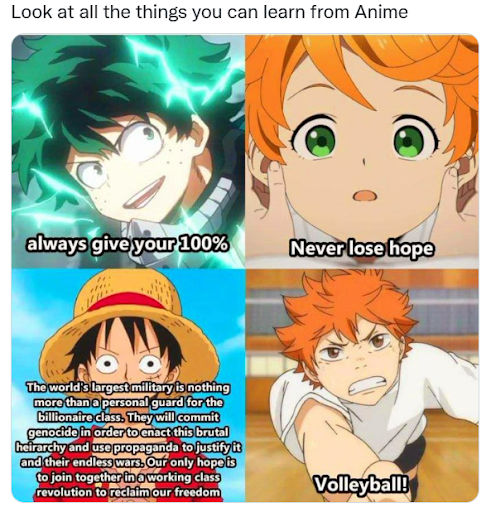The Beating Rubber Heart of One Piece
- January 20 2023
- 3 min read

This year was a big year: I finally caught up on One Piece! During my last read-through attempt, I only made it up to the timeskip and had to dip out to give myself (and my emotions) a bit of a breather. Thankfully, with the Wano arc wrapping up this year, it was a good enough reason to give it another go. And I’m glad I did.
It really can’t be understated how incredible this series is, even after 25 years of publication. Don’t get me wrong, though. It’s far from perfect and has a lot of the same issues that come with the shonen (teenage boy) demographic and the works of the late ‘90s baked into its very DNA. But when its story, characters, themes, action, and humour are in sync, firing on all cylinders? Whew, you just can’t top it. Like, “I’m about to ugly-cry for this damn boat” kind of magic.

Jokes aside, Haikyu!! is very good, too. Please read it. (Source)
That’s all to say that I’ve been thinking a lot about Monkey D. Luffy. A long-running series like this absolutely hinges on its main character, and thankfully Luffy is the heart and engine that keeps this story so engaging. He’s like Paddington Bear with a “Do No Harm, Take No Shit” attitude: he’s hungry, naive, bighearted, makes fast friends, openly questions figures of authority, has no interest in romantic relationships, and is always wearing his signature hat.

Much like the Paddington movies (and Mike Leigh’s Happy-Go-Lucky), the arc of the series is less about Luffy growing as a character and more about Luffy’s ability to continue to be his truest self in the face of incredible adversity. Through it all, as his foes get stronger and the situations more grim and dire, he is always able to bounce back from the brink. In effect, his rubber-based powers, from the Gum-Gum Fruit he accidentally ate as a child, are simply an extension of who Luffy is at his core.
Luffy’s also an easy character to write off at first glance, a reflection of the series’ downright silliness when it comes to its characters and dialogue. One time I jokingly talked about a fictional villain who ate the Snot-Snot fruit only to discover that’s a real character. And Luffy fits right in with this cast of goofballs. He’s always hungry for meat, says things that get himself (and others) in trouble, is not one for subtlety, and is more likely to rush into the fray without a plan.

But for all of Luffy’s silliness, he has incredible clarity when it comes to reading and reacting to the emotions of those around him, especially when they’re at their lowest, most vulnerable states. And this is especially true in Arlong Park.
The Arlong Park arc is one of those perfectly synchronized sections early on where Oda (and his assistants) show you what One Piece is really about and everything just… sings: flashbacks are weaved through in ways that are relevant to the current conflict, the crew’s dynamic solidifies, the fights are thrilling without being too over-the-top, the threat feels real, and it’s all tied back to Nami’s development as a character. All of this culminates in a moment where, at her lowest, she does the bravest thing someone so fiercely independent could do: she asks for help. And boy, does Luffy answer.

As my friend Charlie says, This is One Piece. If you want to know what all the fuss is about, at least make it to chapter 95 of the manga. Trust me.
It’s no surprise that Luffy’s empathy, enthusiasm, and ability to always be his truest self converts his enemies into loyal friends. And as readers, Luffy continues to win us over again and again, as well. Who doesn’t want a friend that can so easily and openly accept us for who we are? Who is so quick to come to our help when we need it? Who knows when to take threats seriously and who knows how to always make us smile?
One Piece, like its titular treasure that kicks off the golden age of pirates, lures in its readers with the promise of grand adventure. And much like the fabled One Piece, I imagine, no treasure will ever be more valuable than the time we’ve spent with Luffy and his crew.

